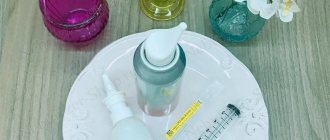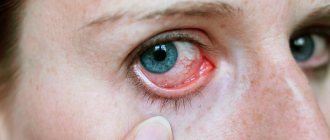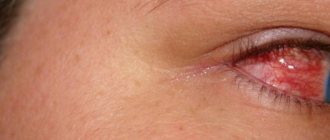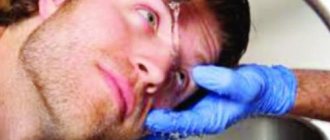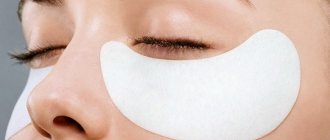Conjunctivitis is a common disease because it has many causes. One of the generally accepted procedures for conjunctivitis, to which there is practically no alternative, is eye rinsing. Both pharmaceutical and traditional remedies are effective. But if you use them incorrectly or choose them “at random,” then instead of curing you can worsen the disease.
Share
Tweet
Share
Cool
Send
Conjunctivitis: types and symptoms
Depending on what caused the disease, conjunctivitis is classified as viral, bacterial or allergic. If the disease began acutely and spontaneously, we are talking about an acute form; if the symptoms last for several weeks, then the conjunctivitis is chronic.
The patient exhibits the following symptoms:
- the whites of the eyes turn red;
- the eyelids also become red and swollen, becoming painful;
- increased tearfulness begins;
- During the day, especially in the morning, there is purulent discharge from the eyes;
- in severe cases of the disease, an increase in body temperature is possible.
The presence of purulent discharge is characteristic of the viral form of conjunctivitis. In this case, rinsing becomes especially important. The best way to wash your eyes depends on how severe your symptoms are.
Children become infected with conjunctivitis somewhat more often than adults. The statistics are explained by the fact that it is not always possible to ensure that a child does not touch his eyes with dirty hands - this is very easy to spread an infection.
Treatment of conjunctivitis
Before you begin treatment if signs of inflammation of the conjunctiva of the eyes appear, you should consult an ophthalmologist. First of all, it will determine the form of the disease. In some cases, conjunctivitis goes away on its own, but in other forms of the disease the process from acute may become chronic or result in a complication.
Conjunctivitis can be caused by the following microorganisms:
- bacteria;
- viruses,
- fungi;
- parasites.
It may be of an allergic nature. Only a doctor can determine the cause of the disease and prescribe comprehensive treatment. It will be as follows:
- washing with antiseptic solutions;
- instillation of eye drops;
- applying ointments with antibiotics or corticosteroids;
- compliance with hygiene measures.
When prescribing eye drops, the following features of the disease are taken into account:
- infectious agent;
- patient's age;
- individual characteristics of his body;
- tolerability of the drug or its ingredients.
Since in most cases conjunctivitis is caused by an association of different pathogens, the doctor usually prescribes several medications. To treat inflammation of the conjunctiva of bacterial origin, eye drops based on antibiotics and antiseptics are used:
- "Levomycetin";
- "Sodium sulfacyl";
- "Ofloxacin";
- "Oftaquix";
- "Normax";
- "Tobrex";
- "Tsipromed".
The latter drug is part of the complex therapy of viral conjunctivitis. Tobrex is successfully used to treat inflammation of the conjunctiva in children and adults.
If conjunctivitis is caused by viruses, it is recommended to use the following drugs:
- "Aktipol";
- "Poludan";
- "Ophthalmoferon".
If the disease is of an allergic nature, the following eye drops are indicated:
- "Allergodil";
- "Cromohexal";
- "Vizin";
- "Opatanol";
- "Lecrolin."
These are not all the drugs that are used to treat conjunctivitis. The ophthalmologist will decide which of them to prescribe after examining the patient. He will also determine a treatment regimen taking into account the individual characteristics of the body. You should not use medications without a doctor’s prescription.
Flushing with medication
Treatment of conjunctivitis should be comprehensive. Doctors usually recommend using antibacterial and antiviral eye drops, rinsing the eyes, and placing tetracycline ointment behind the eyelid.
How to wash your eyes with conjunctivitis:
- furatsilin . 1 tablet of furatsilin is diluted in 100 ml of boiled water. The resulting solution must be filtered;
- potassium permanganate or potassium permanganate . You will need a weak solution; the water should turn light pink.
All medication solutions must be used fresh, immediately after preparation. You cannot prepare them for future use or store them in the refrigerator.
A good therapeutic effect will be achieved if, in addition to washing the eyes with medicinal agents, auxiliary drugs are used. These include drops “Interferon” and “Derinat”. They have an immunomodulatory effect, accelerate tissue regeneration, and promote better outflow of intraocular fluid. Derinat can be used by pregnant women; it will not have a negative effect on the fetus.
Is it possible to rinse the eyes with saline solution for conjunctivitis?
Saline solution is one of the most harmless means and has virtually no side effects. In its composition, it is as close as possible to the tear fluid that our body produces. You can and should wash your eyes with saline solution 2-3 times a day, a few drops in each eye. It is convenient to use a pipette for this.
Can I rinse my eyes with chlorhexidine?
It is possible if you are not allergic to this drug. It is enough to moisten a cotton swab in it and cleanse the eyes of purulent discharge. Chlohexidine should not be poured in large quantities over the eyelids.
How to properly rinse your eyes for conjunctivitis
Follow the rules for washing your eyes so as not to spread the infection and harm the visual organ.
- Sterility. To rinse the inflamed conjunctival cavity, boil water. You need to boil for at least 10 minutes. For washing, you need to use sterile cotton wool or gauze wipes, a pipette. It is impossible to achieve complete sterility at home. It is enough to disinfect the items used as much as possible.
- Temperature. Cool the finished solution to a warm temperature, no more than 37 degrees. Strain through several layers of gauze. Using an eyedropper, place a few drops into each eye. Another option is to fill a container with the solution, dip your face and blink. Then wipe with a napkin. Do not reuse the spent solution.
- Direction. How to properly wipe your eyes with conjunctivitis? You need to wipe with a napkin from the outer corner to the inner. If there are dried crusts, soak them before removing. This is necessary so as not to damage the skin. Be sure to use a different wipe for each eye to prevent the spread of infection.
- Concentration. If you prepare the solution yourself, strictly follow the concentration indicated in the instructions.
Eye rinsing for conjunctivitis is carried out with solutions with antimicrobial, antiviral, antiseptic effects, anti-inflammatory and soothing effects.
What should you not do if you have conjunctivitis? It is forbidden to wash the conjunctiva with a hot solution or alcohol-containing products. Don't rub your eyelids too hard. You cannot use the same napkin multiple times.
What is conjunctivitis, how does it happen and how to treat it - read here.
Washing with traditional medicine
Traditional medicine confirms the effectiveness of medicinal rinses. It is recommended to use the following recipes:
- the most accessible remedy is saline solution. 1 tbsp. l. You need to mix table salt in a glass of boiled water, treat your eyes with this solution in the morning and evening;
- Strong brew of black tea is a good antiseptic. It needs to be strained so that tea particles do not get into the eye. Naturally, the brew should not contain any other additions in the form of sugar or other herbs;
- mix 1 tbsp. l. boiled water, 1 tsp. liquid honey, and a few drops of aloe , drop 2-3 drops into the eyes once a day;
- 5-6 pcs. bay leaf in 200 ml of water for 10-15 minutes, strain, rinse eyes 2-3 times a day;
- 40-50 g of dried calendula flowers into 250 ml of boiling water, leave for at least 8 hours, strain, rinse the eyes with warm solution if purulent discharge appears.
If traditional medicine methods do not bring improvement in the next two to three days, you need to use stronger drugs. Sometimes treatment for conjunctivitis requires the use of antibiotics.
Washing in children
For safety reasons, adults should wash a child's eyes.
Read in a separate article: How and with what to cure conjunctivitis with folk remedies
How to treat the disease in children:
- concentrated chamomile solution. To do this, you need to pour 50 g of dry chamomile into 200 g of boiling water and leave for 5 hours, then strain. Chamomile has excellent antiseptic properties;
- For children, doctors often recommend Albucid eye drops. Their main active ingredient is sulfacetamide, it destroys pathogenic bacteria. A contraindication to the use of Albucid is hypersensitivity to a number of sulfonamides.
It must be remembered that the child’s body does not have a fully formed immune system, and the likelihood of complications from this becomes somewhat higher. Therefore, adults should ensure that all medical recommendations are strictly followed.
Children need to properly wipe their eyes several times a day, at least twice - in the morning and in the evening.
Sodium chloride solution - how is it used in ophthalmology?
The saline solution is a 0.9% sodium chloride solution. It can be purchased at the pharmacy in ready-made form (sold in vials or in the form of injections). You can also prepare it yourself by mixing water and salt in certain proportions. But for eye washing and other medical procedures where sterility and dosage accuracy are important, it is recommended to use ready-made pharmaceutical solutions.
The peculiarity of the saline solution is that its composition is as similar as possible to the composition of the fluids of the human body, therefore it does not cause allergic reactions, is well tolerated even by children and is prescribed to people with hypersensitivity of the mucous membranes.
Saline solution in ophthalmology is used mainly for washing and moisturizing the eyes. A doctor may recommend its use if the following indications exist:
- different forms of conjunctivitis;
- itching and discomfort in the eyes caused by prolonged work at the computer;
- excessive dryness of the visual organs (in this case, the solution is used as a substitute for natural tears);
- foreign body or speck in the eye;
- eye care for newborns.
Despite its high compatibility with human body fluids, there are some contraindications to the use of saline solution. Therefore, you should not use it even for washing your eyes without consulting a doctor.
Eye wash rules
Rinse your eyes according to the following rules:
- the face must be completely cleansed of cosmetics;
- hands are washed clean, the edges of the nails should not be sharp;
- only sterile materials are used: bandage, gauze, cotton pad;
- the movement of the hand follows from the outer corner to the inner;
- after finishing washing, hands should be treated with an antibacterial agent;
- Rinsing is carried out before using eye drops and ointments; about 10-15 minutes should pass between procedures.
All adult family members should know how to properly wash their eyes during conjunctivitis. Compliance with these rules will prevent the spread of infection and prevent possible complications.
Recommendations for patients
If you have conjunctivitis, you should avoid touching your eyes with your hands to avoid transmitting infectious agents. It is also necessary to use an individual towel and avoid visiting crowded places. When signs of inflammation disappear, it is recommended to continue treatment for the time prescribed by the ophthalmologist.
When using a pipette, it should not touch the eyelids, eyelashes and eyeball. The first instillation should be given to the affected eye. This also includes putting ointment under the eyelid from a tube. If you have allergic conjunctivitis, you must avoid contact with the allergen.
Prevention
The occurrence of conjunctivitis is much easier to prevent than to treat. For prevention purposes, it is recommended to take the following measures:
- do not rub your eyes with dirty hands;
- if one of the family members has conjunctivitis, close contacts with him should be limited as much as possible;
- for colds and infectious diseases, the course of treatment should always be completed;
- It is advisable for each family member to have their own separate face towel.
Thanks to modern medications, conjunctivitis in most cases is cured in an average of 6-7 days, without further negative consequences for visual function.
Author of the article: Elizaveta Viktorovna Klokova, specialist for the website glazalik.ru Share your experience and opinion in the comments.
Conjunctivitis - what is it and why is it dangerous?
Conjunctivitis is a disease that is accompanied by redness of the eyes, burning, itching, and watery eyes. There are several types of conjunctivitis, each of which requires its own treatment and can lead to serious complications if it is not treated.
Viral
You should suspect it if the general symptoms include a reaction to bright light, blurred vision, or discharge from the eyes that gets worse over time. There may be pain in the ear area, the appearance of tubercles (lymph nodes) near the ears and on the neck.
This type of conjunctivitis is dangerous because it is contagious, can spread to the eyelids (blepharitis), cornea (keratitis), and leads to a sharp drop in visual acuity.
Bacterial (purulent)
The symptoms of bacterial conjunctivitis are similar to the infectious form. Redness occurs sharply, the eyes fester. The eyelids swell, stick together and become crusty, and thread-like mucus forms in the lower fornix.
In this case, it is very important to maintain hygiene, otherwise the inflammatory process will spread to the cornea. Pus can also accumulate in the anterior chamber of the eye (hypopyon).
Fungal
Fungal conjunctivitis is caused by about 50 species of fungi. It is accompanied by ulceration of the conjunctiva, the formation of a greenish coating and films. Discharge from the eyes is often absent or minor. The later the fungus is discovered, the more difficult it is to treat. And attempts to cope with it on your own can even lead to the death of the eye.
Important: viral, fungal and bacterial conjunctivitis are contagious. And if left untreated, they become chronic.
Allergic
This will be indicated by swelling of the eyelids and itching. Moreover, the more the patient rubs his eyes, trying to get rid of discomfort, the more pronounced the symptoms appear.
Often this type of conjunctivitis occurs due to an allergy to pollen (hay fever) or contact lenses. You cannot treat it yourself; this can provoke an even worse allergic reaction.
Traumatic and chemical
These types of conjunctivitis are associated with exposure to external factors on the eyes. In case of traumatic injury, it is a foreign body entering the eye. Accompanied by pain, pressing, stabbing sensations, a feeling of fullness and sand in the eye.
As a rule, inflammation of the conjunctiva occurs in one eye, and often the patient guesses how he received the injury. Do not try to remove the foreign body yourself! See a doctor immediately!
Chemical conjunctivitis is associated with substances that contain acids and alkalis getting into the eye. These components cause a burn, which leads to inflammation of the mucous membrane. An eye burn is an ophthalmological emergency and can lead to low vision.
